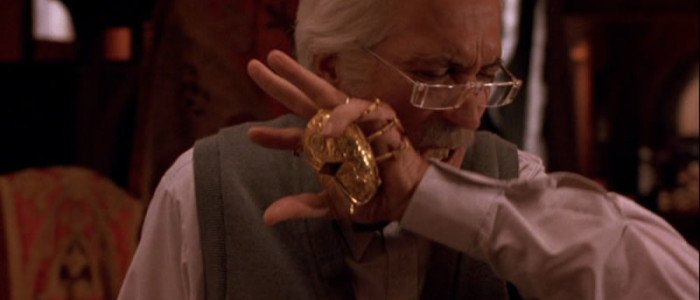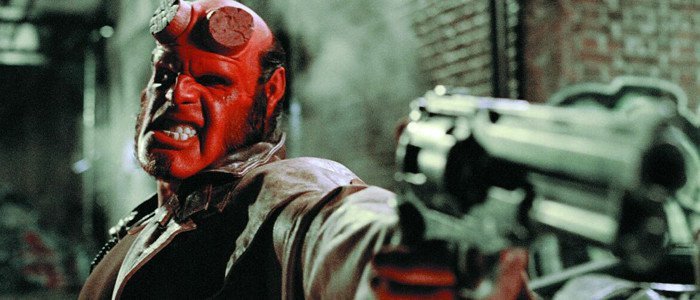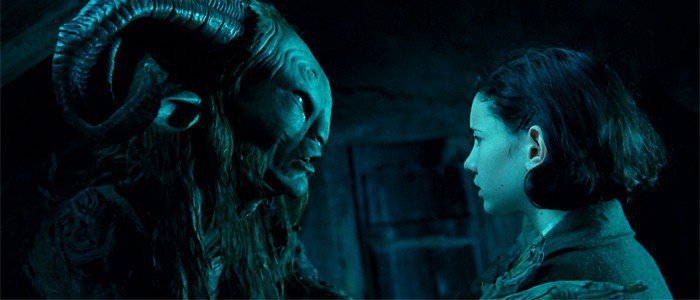Four Great Guillermo Del Toro Audio Commentaries
There's one word that pops up more than any other in filmmaker Guillermo del Toro's commentaries: love.
An Academy Award nominee this year for The Shape of Water, del Toro has nothing but affection for his worlds and characters, even some of the most monstrous of his creations. The director always finds light in the darkest corners of his filmography. As often as del Toro is lauded for his imagination, his commentaries are a reminder that, as a storyteller, he doesn't get enough credit for the amount of empathy he displays.
The Mexican filmmaker is constantly wearing his passion and sincerity on his sleeve, partially because he's never at a loss for words in his commentaries. I've listened to some of the tracks recommended below more than once, and the second time around, it was still like holding a key to unlock the mind of the visionary for two wonderful hours. Commentary tracks were made for directors like Guillermo del Toro.
Here are four must-hear Guillermo del Toro audio commentaries.

Cronos
Why Listen: The track for del Toro's $2 million directorial debut gives you the most insight into the director's life before stepping behind the camera. It's arguably his most personal track. He shares details from his upbringing, most notably his relationship with religion and his grandmother, who was perhaps the leading influence for Cronos. del Toro covers his childhood quite a bit, explaining how many of his interests were born. The fact that he was reading medical manuals and had an obsession with death early on in life sounds about right for this master of the macabre.What's Said: Religion has played a prominent role in del Toro's body of work. The lead actor in Cronos, played by Federico Luppi, is named Jesus and "has a red velvet cape, much like Christ got his during the passing," so religion is very much at the forefront of del Toro's debut. del Toro explained how the references came from his upbringing and complicated feelings about religion:
These references about vampirism and what I view as communion and the rites of the Catholic church are never done, from my part, in a disrespectful way. They are just my extrapolation from a lot of the mixed feelings I had about the rites as the child and the more disturbing aspects if you would. When they tell you that you have to eat the flesh of Christ and drink his blood as a child, it's a little too big of a metaphor to swallow that easily. It's me dealing with my Catholic issues, and it's never meant as a smart, smug comment on something. It's really heartfelt and troubling for me, in a way, and I try to deal with it.
A Day on the Job: del Toro's unofficial film school was an anthology horror/sci-fi series called La Hora Marcada (Translation: The Marked Hour), which led to a friendship with another director working on the show, Alfonso Cuarón (Gravity). During their time on the show, del Toro experimented. They wanted to try new techniques and tricks with the camera, and some of that experimenting led to a choice made on Cronos:
For many years, Alfonso Cuarón and I have been friends and worked on a TV series where we tried a little something on every episode. We were very modest in our ambitions and would say, "We're going to experiment with the dolly moves and fade-outs," and other modest goals for this horror series that I loved. It was an unofficial film school given to us by the great producer Carmen Armendáriz, the daughter of the great actor Pedro Armendáriz. With these experiments, I was always left with the desire to do a montage with a voice-over [which happens in Cronos]. Don't ask me why, it's just one of those kinks or little things you want to do.
Trivia: Cronos has direct references to Eyes Without a Face, The Night of the Hunter, and Sleeping Beauty.
Hellboy
Why Listen: del Toro's outpouring of love for Ron Perlman continues on this track for his 2004 comic book movie, which faced all kinds of apprehension from the studio brass. From day one, the director didn't want to make the X-Men-esque movie the marketing department portrayed Hellboy as. The studio couldn't even get fully onboard with Hellboy having a tail! del Toro talks about how he tried to make a movie that referenced more than recent comic books and The Matrix, and he mentions what seems like every single one of his influences. Get ready for a whole lot of book recommendations you'll want to write down. One major influence? The late, legendary Ray Harryhausen, who told del Toro: "Most people animate monsters acting like monsters, being mean and destructive. Monsters should be thought of as animals."What's Said: In del Toro's (very correct) opinion, Perlman has a beautiful voice, a very "colloquial voice." The filmmaker loves the "been there, done that" quality of the actor's deliveries. He wrote all of Hellboy's lines with Perlman's voice in mind. Here's a little more praise from the filmmaker for his frequent collaborator:
To me, Ron Perlman is the Lon Chaney of the 21st Century. He's an actor who not only knows how to wear makeup and make the makeup come alive, he is an actor who can be subtle in makeup. He can do nuance in makeup. Some great actors never get used to makeup, some great actors are really good at it. Laurence Olivier, being one, and Peter Sellers being another one. It is a gift. It's not something you can be trained for or explain to another performer. It's a gift, and Ron has that gift in spades.
A Day on the Job: No matter how fantastical his worlds or characters are, del Toro often finds himself drawing from his own life experiences. Liz's (Selma Blair) rubber bands on her wrists, for example, were inspired by what the filmmaker witnessed while working at a mental institution:
Liz using those rubber bands to keep herself at bay and from exploding, this is actually something from when I was working as a volunteer at a mental instituion in my hometown of Guadalajara [Laughs]. It's a long story, but I picked up a guy who had an accident in the street, turned out he was mentally deficient, and I took him to the hospital and they sent him to a mental asylum. When I went to visit the poor man to see how he was the next day, he had escaped. I went to the director of the asylum and asked why is it so easy for patients to escape, she said, "Well, we're short of hands. If you care that much, why don't you join the staff?" I proceeded to join the staff.
This mental institution was strategically placed behind a 19th-century cemetery, next door to the morgue. During the period in that institution, which was a brief few weeks, I was exposed to some of the most beautiful monuments. I used to have my lunch there and write a little, in a cemetery for many years. At the same time, I was exposed to the most horrible things as I went through the morgue to the parking lot. But one of the things I picked up during that stay was they gave some of the patients some tricks since they couldn't give them the exact assistance they needed, to keep them at bay. One of them was that: to use the rubber bands to help themselves remind themselves they were about to lose their temper.
Remember how the villain's eye rolls back in Pan's Labyrinth when he's shot? That was also inspired by this period in del Toro's life. When he was at the morgue, he saw a man who was shot in the face whose eye had rolled back.
Trivia: Some theaters in the South didn't want to have "Hellboy" next to Passion of the Christ on marquees, so they put "hello boy" instead.
Pacific Rim
Why Listen: One of the many reasons del Toro's commentaries are a joy is that there's rarely a frame that doesn't glue your eyes to the screen as the filmmaker speaks, eloquently and passionately. Frame after colorful frame is a delight to the eyes, but it's not "eye candy" to del Toro's – it's "eye nutrition." Throughout this track, which could make even the harshest critics appreciate more of the film, del Toro digs deep under the aesthetic. There's plenty of world-building chatter that's informative and surprising, like how del Toro took a note from Paul Schrader's approach to American Gigolo. Del Toro's attention to detail for every nook and cranny of his films is always evident, but it's perhaps most apparent in his Pacific Rim track.
While del Toro's biggest movie is also maybe his most divisive, it has some notable fans: author William Gibson ("to love the movie you have to love it on its own terms," he said), Kanye West, Howard Stern, and filmmaker Takashi Miike.
What's Said: Mako's hair doesn't have a blue strand simply because it's a cool look; it's about her relationship with Kaiju. Del Toro helped define her and other characters with his color palette choices:
Mako and Raleigh here need to trust each other and find common ground. The two scientists need to trust each other even if they hate each other. The father needs to trust the son, and the father needs to trust the daughter. That theme is repeated throughout the movie; it's about colors coming together. Raleigh is coded with these warm, gold colors, with warm greens, earth tones, and the light bathing him is always golden. It's about that color coming together with Mako's dominant color, and Pentecost's, which are blues. I color coded this scene entirely with those two colors: the bright ambers and the blue. This is Mako meeting Raleigh, so it needs to be color coded like that. Mako is blue because I'm linking her origin to the Kaiju blue, the blood of the Kaiju.
A Day on the Job: The scene where Mako and Raleigh's colors start to connect is what del Toro calls the equivalent of a 19th Century waltz. When they discover they are drift compatible during training, del Toro made sure to bring in a new color to help the characters and scene have more life:
I wanted to shoot this fight like a dance, a courtship, and a moment of connection. We shot enough coverage and enough ways I could graduate the degree of chemistry between them and end the movie with Mako and Raleigh finding each other. We talked about the color red, and here it becomes very important. We have these characters fighting in an area that's very color coded to be warm, with a lot of reddish art direction. We color-coded this arena in black and red...everything is permeated with red, because I wanted red to symbolize the heart.
Trivia: When we meet Hannibal Chau – "the strangest creature on the screen" – in Hong Kong, del Toro envisioned "a living incarnation of Heavy Metal [magazine]" with a heavy saturation of colors.
Pan's Labyrinth
Why Listen: del Toro typically covers all the bases with his tracks, but he sometimes cover more subjects than others. If you want to know more about del Toro the screenwriter, Pan's Labyrinth is the one to hear. As it did for many people, 9/11 drastically altered how del Toro saw the world, which changed how he told stories. With Pan's Labyrinth, like The Shape of Water, he wanted his period piece to reflect today's world with a story about "choice and disobedience." del Toro's masterpiece is probably his fullest story-wise, and with this track, he lays bare all the story's motivations, influences, and themes.What's Said: The Pale Man sequence remains a sublime blend of beauty and fear and it has a fan in one of the kings of horror:
I had the privilege of watching this particular scene with Stephen King in New England. I must say, it remains the single best screening experience of my life to be sitting next to Stephen King and watching him squirm during the Pale Man sequence. That, for me, is an Oscar. That's absolutely the best thing that ever happened to me in my life.
The Pale Man, by the way, was initially conceived as an old man who lost a lot of weight. Del Toro scrapped the design, rethought the child-eating creature, and delivered one hellish creature.
A Day on the Job: Technically speaking, one creature caused the most trouble on the set:
This was a nightmare to shoot. This giant puppet frog was supposed to move around, be very articulated, and mobile. We had a disagreement on how to approach it technically, and unfortunately, I was right. I told them it would not be able to move and it's too heavy, and it was too heavy and didn't move. We had originally constructed a huge set for the frog, but I ended up having to shoot him in the gallery of roots. At the end of the day, it's for the good of the movie, because the frog obviously looks bigger in a smaller set. With a bigger set and immobile frog, the frog would've looked little, so we dumped an entire set because the frog was not able to jump around.
Del Toro credits Cafe Effects for the scene, which had the most challenging effects shot: the frog throwing up. The frog, by the way, is half CG, half puppet. In addition to being a terrific design, the frog is a prime example of compromise producing fantastic results.
Trivia: The story was originally about a pregnant woman falling in love with a faun living in a Labyrinth. "They made passionate love, she fell in love with him, and he asked for the blood of the firstborn in return for the labyrinth to open and for her to go to the magical kingdom with him," del Toro shared.
